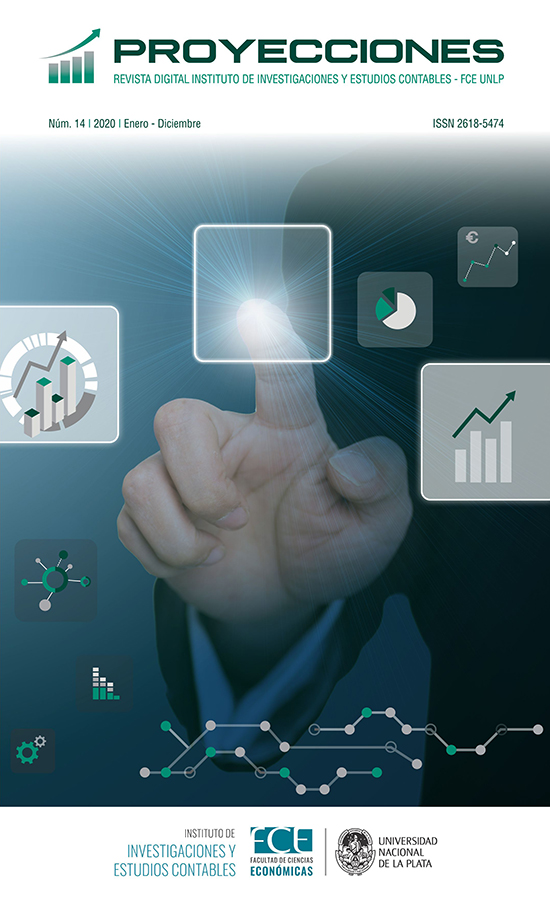Tax benefit of the donations made to universities and professional institutes in Chile
DOI:
https://doi.org/10.24215/26185474e011Keywords:
tax incentive, donations, tax microsimulationAbstract
This investigation analyses the effect on the distribution of monetary resources that the Taxpayers of the First Category Income Tax who make donations to universities and higher education institutions have to face, according to article 69 of Law 18.681. The latter provision, considered as a "tax benefit", grants a credit of 50% of the donated amount, considering the other 50% as an accepted expense if it complies with the requirements of paragraph 7 of article 31 of the Income Tax Law. The main objective is to determine the effect of such benefit on the flow and reflect on the effectiveness of the resources generated in the Fiscal Year 2018 Tax Operation.
Qualitative research was carried out to analyse the dispositions of the above-mentioned Law through a tax microsimulation process based on the generic data of the taxpayers who made the donations to illustrate the effects obtained. Subsequently, a numerical exercise was determined, which specified the result of applying the provision, to analyse later the general figures that the Internal Revenue Service reported on the Fiscal Year 2018 Tax Operation statements.
As a result, the net social flow was $12,750 MM, understood as the total of resources that were applied to higher education institutions as donations (qualitative assessment). It was also determined that the provision under study is not a benefit but a "prize" that the legislator grants to the taxpayers who make donations for altruistic reasons.
Downloads
Metrics
References
Beranek, W., Kamersche, D. R. y Timberlake, R. H. (2010). Charitable donations and the estate tax: A table of two hypoteses. American Journal of Economics and Sociology, 69(3), 1054-1078. https://onlinelibrary.wiley.com/doi/abs/10.1111/j.1536-7150.2010.00732.x
Fazio, H. (2003). ¿Quiénes Gobiernan América Latina? Editorial Universitaria Academia de Humanismo Cristiano.
Grant, N. L. (2016). Correlated Random Effects Quantile Estimation of the Tax Price Elasticity of Charitable Donations. Economics Bulletin, 36(3), 1729-1729. http://www.accessecon.com/Pubs/EB/2016/Volume36/EB-16-V36-I3-P169.pdf
Hossain, B. y Lamb, L. (2012). Does the effectiveness of tax incentives on the decisión to give charitable donations wary across donation sector in Canada? Applied Economics Letters, 19(15), 1487-1491. https://www.tandfonline.com/doi/abs/10.1080/13504851.2011.636016
Jiménez, J. P. y Podestá, A. (2009). Inversión, Incentivos Tributarios en América Latina. Revista Serie Macroeconomía del Desarrollo de la CEPAL, (77). http://proyectos.andi.com.co/czf/Documents/Documentos%20de%20Interes/Microsoft%20Word%20-%20Inversión,%20Incentivos%20fiscales%20en%20America%20Latina%20Cepal%20Documento.pdf
Jorrat, M. (2012). Gasto Tributario y Evasión Tributaria en Chile: Evaluación y Propuestas. CIEPLAN.
Lacetera, N., Macis, M. y Stith, S. S. (2014). Removing financial barriers to organ and bone marrow donation: the effect of leave and tax legislation in the US. Journal of health economics, 33, 43-56. https://www.ncbi.nlm.nih.gov/pubmed/24240145
Ley N° 18.681. Establece Normas Complementarias de Administración Financiera, de Incidencia Presupuestaria y Personal. Diario Oficial de la República de Chile, 31 de diciembre de 1987.
Ley N° 19.885. Incentiva y Norma el Bueno Uso de Donaciones que dan Origen a Beneficios Tributarios y los Extiende a otros Fines Sociales y Públicos. Diario Oficial de la República de Chile, 6 de agosto de 2003.
Ley sobre Impuesto a la Renta, contenida en el artículo primero del Decreto Ley 824 de 1974. Diario Oficial de la República de Chile, 31 de diciembre de 1974.
Mella, O. (2003). Metodología Cualitativa en Ciencias Sociales y Educación. Editorial Primus.
Musgrave, R. y Musgrave, P. (1992). Hacienda Pública, Teórica y Práctica (5ª ed.). Mc Graw Hill.
Perrotini, I. (2002). La Economía de la Información Asimétrica: Microfundamentos de Competencia Perfecta. Revista Aportes de la Benemérita Universidad Autónoma de Puebla, 7(9), 59-67. http://redalyc.uaemex.mx/redalyc/pdf/376/37601903.pdt
Petersen, T. S. y Lippert-Rasmussen, K. (2011). Ethics, organ donation and tax: a proposal. Journal of medical ethics, 38, 451-457. https://jme.bmj.com/content/38/8/451?int_source=trendmd&int_medium=trendmd&int_campaign=trendmd
Pinto Perry, G. (2011). Efecto en el Patrimonio de Contribuyentes que Adoptan Beneficios Tributarios del Impuesto a la Renta. Capic Review, 9(1-2). http://www.capic.cl/wp-content/uploads/2015/10/vol9art7.pdf
Rauscher, M. (1998). Leviathan and Competition among Jurisdictions: The Case of Benefit Taxation. Journal of Urban Economics, 44(1), 59-67. https://www.sciencedirect.com/science/article/pii/S009411909792060X
Samuelson, P. (1967). Curso de Economía Moderna, una Descripción Analítica de la Realidad Económica (15ª ed.). Editorial Aguilar S.A.
Silva Escobar, D. (2015). Max Weber, los fundamentos metodológicos de Economía y Sociedad y la naturaleza de los fenómenos económico-sociales: comentarios y críticas. Persona y Sociedad, 29(1), 37-61. https://d1wqtxts1xzle7.cloudfront.net/38671215/Articulo_sobre_Weber__Daniel_Silva_Escobar.pdf?1441421695=&response-content-disposition=inline%3B+filename%3DMax_Weber_los_fundamentos_metodologicos.pdf&Expires=1604704845&Signature=fsg-2cj6jozHbn4DOanbqoGb7xLPwC~jI3vT2PyhA3pLv8NjczbtPr2I~NWTCKQNlmCc8dOZEJRzz7L1K5lRh6VDoT5ir5DSE8GCZ6pucIzY1b10~sda7N-EGfXhfR-BO~mkzQoCqKfOYsnVieLRWhsZaZsiYIcHdOV4r5GQCOI55UbmcmF6UYMhht9IurSsPhng1zWzD4YBQJQqPfxFsNqwQekRETIsWtvFAKT6SAzfAUFJIdZy~dOJv-3YS0J~amfqoRZxd0o3pkTbI7-nfBj-GvNs6E9lcZeDr52J9r1~OesPDgFlIzxxBGuQmeNRxcdaE0Ru32I7IbH7vXVDCQ__&Key-Pair-Id=APKAJLOHF5GGSLRBV4ZA
Venkataramani, A. S., Martin, E. G., Vijayan, A. y Wellen, J. R. (2012). The impact of tax policies on living organ donations in the United States. American Journal of Transplantation, 12(8), 2133-2140. https://onlinelibrary.wiley.com/doi/full/10.1111/j.1600-6143.2012.04044.x
Additional Files
Published
How to Cite
Issue
Section
License
El material publicado en la revista se distribuye bajo una licencia de Creative Commons de Atribución-NoComercial-SinDerivadas 4.0 Internacional (CC BY-NC-ND 4.0). Esta licencia obliga a otros a dar crédito de manera adecuada, brindar un enlace a la licencia, e indicar si se han realizado cambios; no permite hacer uso comercial de la obra; y si se remezclara, transformara o creara otro material a partir de la obra, no podrá ser distribuida esa modificación.




























